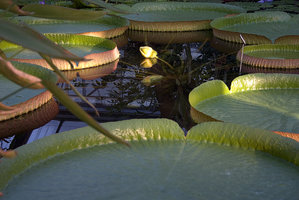Victoria (genus)
| Victoria | ||||||||||||
|---|---|---|---|---|---|---|---|---|---|---|---|---|

|
||||||||||||
| Systematics | ||||||||||||
|
||||||||||||
| Scientific name | ||||||||||||
| Victoria | ||||||||||||
| Lindl. |
Victoria is a genus of plants in the family of the water lily plants (Nymphaeaceae), which are also called giant water lilies in German because of their enormous leaf size. The only two species are native to South America.
description
The circular leaves float on the water. They have pin-prick-fine pores (stomatodes) and two opposing notches in the arched edge so that rainwater can run off quickly. They owe their stability and buoyancy to a strip-shaped support fabric on the underside of the leaf that follows the vein network. The support strips contain large, air-filled intercellulars and are studded with spikes. Larger spines can also have air-filled cavities, while smaller ones are massive. All parts of the plant lying under water (underside of the leaves, stems and the outer tepals of the flower covers ) are covered with hard, pointed spines, which are supposed to protect against herbivores.
In their natural range, the plants can bloom all year round. Both species of the genus bloom exclusively at night and both species are capable of thermogenesis . The anthesis only lasts about two days. Pollination is carried out by beetles, which crawl into the open flowers on the first night, remain trapped in the closed flower on the following day and are only released again on the second night. While the flowers are closed during the day, the formation of anthocyanins changes their color from white on the first night to a dark purple-red on the second night.

Systematics
The genus Victoria belongs to the subfamily Nymphaeoideae within the family of Nymphaeaceae , formerly Euryalaceae.
The only two species in the genus Victoria Lindl. are:
- Amazonas giant water lily ( Victoria amazonica (Poepp.) JCSowerby , Syn .: Euryale amazonica Poepp. , Nymphaea victoria R.H. Schomb . Ex Lindl. Nom. Inval., Victoria amazonica Planch. Ex Casp. , Victoria regia Lindl. , Victoria regia var. randii hort. ex Conard nom. inval., Victoria regina R.H. Schomb . ): The home is the catchment area of the Amazon in South America. There are localities in Guyana , in the Brazilian states of Acre, Amazonas, southern Mato Grosso, western Mato Grosso do Sul, Para and Rondonia and in Bolivia (Beni, Pando, Santa Cruz).
- Santa Cruz giant water lily ( Victoria cruziana A.D.Orb. , Syn .: Victoria argentina Burmeist. Nom. Nud., Victoria cruziana var. Malmei F.Henkel et al. , Victoria cruziana var. Trickeri F.Henkel et al. , Victoria regia var. cruziana (ADOrb.) C.Lawson , Victoria trickeri (F.Henkel ex Malme) hort. ex Mutzek ): The home is in the river system of the Rio Paraná . There are sites in Argentina (Chaco, Corrientes, Entre Rios, Formosa, Santa Fe) and Paraguay .
The two species can be crossed with each other, which takes place in botanical gardens .
Botanical history
The Victoria was discovered before 1816 by Thaddäus Haenke , then in 1832 by Eduard Friedrich Poeppig , a botanist born in Plauen in the Vogtland. It was not named until five years later when Sir Robert Schomburgk discovered the water lily in Guiana on behalf of the Royal Geographical Society of London and named it Nymphaea victoria in honor of Queen Victoria (1819-1901) . John Lindley then validly described it as the Victoria regia .
The leaves can weigh up to 60 kilograms.
Individual evidence
- ↑ a b c d e f Victoria in the Germplasm Resources Information Network (GRIN), USDA , ARS , National Genetic Resources Program. National Germplasm Resources Laboratory, Beltsville, Maryland. Retrieved January 3, 2014.
- ↑ a b c Walter Erhardt , Erich Götz, Nils Bödeker, Siegmund Seybold: The great pikeperch. Encyclopedia of Plant Names. Volume 2. Types and varieties. Eugen Ulmer, Stuttgart (Hohenheim) 2008, ISBN 978-3-8001-5406-7 .
- ↑ a b c RB Kaul: Anatomical Observations on Floating Leaves. In: Aquatic Botany , Volume 2, 1976, pp. 215-234, ( digitized ).
- ↑ a b KA Warner, PJ Rudall & MW Frohlich: Differentiation of perianth organs in Nymphaeales. In: Taxon , Volume 57, Number 4, 2008, pp. 1096–1109, ( digitized version )
- ↑ a b c GT Prance & JR Arias: A study of the Floral Biology of Viciaria amazonica (Poepp.) Sowerby (Nymphaeaceae). In: Acta Amazonica , Volume 5, Number 2, 1975, pp. 109-139, ( digitized version ).
- ^ A b c d I. Lamprecht, E. Schmolz, L. Blanco & CM Romero: Energy metabolism of the thermogenic tropical water lily, Victoria cruziana. In: Thermochimica Acta , Volume 394, 2002, pp. 191-204, ( digitized version ).
- ↑ Nymphaeaceae Victoria Lindl. . In: Plant Name Details . International Plant Name Index. 2005. Retrieved April 4, 2009.
- ↑ Kit Knotts: Victoria's History . In: Victoria Adventure . Knotts. Retrieved November 14, 2012.
- ↑ George Ripley, Charles Anderson Dana: Leaf . In: The New American cyclopaedia: a popular dictionary of general knowledge , Volume 10. Appleton , New York 1861, p. 992.
